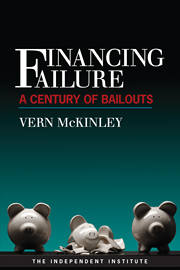Timothy Geithner is in full “swan song” mode. Word is he will give up his job as secretary of the treasury at the end of 2012, regardless of whether President Obama wins or loses in November.
To influence history’s judgment of his tenure as president of the New York Fed and as treasury secretary, he is now aggressively shaping a glowing narrative. This explains his current victory lap in the media highlighting the fourth anniversary of the bailout of Bear Stearns.
He recounts how the CEO of Bear, with his firm on the brink of bankruptcy, came to him looking for a shoulder to cry on. From his then leadership perch as president of the New York Fed, the bank ultimately extended nearly $30 billion for a bailout, the first in a series of such interventions.
Although this effort to shape a narrative has begun, the countervailing narrative is also clear. This narrative couches the bailout of Bear Stearns as the “original sin,” the first in a series of short-sighted interventions with negative consequences and highlights that our system is just as vulnerable, if not more vulnerable, to similar crashes in the coming years.
Regulatory breakdowns
Since the stock market crash in 1987, the Federal Reserve, and in particular the New York Fed, has taken on a much broader role as a preventative early warning mechanism, acting as the “fire department for the financial system,” in Geithner’s words. Under his guidance the New York Fed was inept at filling this role. The bank was caught completely off-guard by emerging problems at Bear Stearns, AIG, Wachovia, Citibank and others.
Fear-mongering
More than any other key participant in the bailouts, Secretary Geithner was infamous for using hyperbolic language to provoke intervention. This “Chicken Little” approach undermined market confidence and likely made the panic among investors even worse.
He started the scary descriptions with testimony in April 2008 recounting his vision of what would have happened had Bear Stearns been allowed to fail: “A failure to act would have added to the risk that Americans would face lower incomes, lower home values, higher borrowing costs for housing, education, other living expenses, lower retirement savings and rising unemployment.”
Of course, the bailout of Bear Stearns was no elixir, as we ultimately did face lower incomes, lower home values, lower retirement savings and rising unemployment.
Secrecy
Unwilling to come clean on the what and the why of all the bailouts, the Federal Reserve, Treasury, FDIC and Federal Housing Finance Agency went to great lengths to keep their decision-making process cloaked in secrecy. This led to more uncertainty as to the logic behind the bailouts.
Even Secretary Geithner has acknowledged the uncertainty from the ever-changing and arbitrary justifications for intervention: “(a)s the crisis intensified and more dramatic government action was required, the emergency actions meant to provide confidence and reassurance too often added to public anxiety and to investor uncertainty.”
Bloomberg News had a high profile lawsuit to compel the Federal Reserve to disclose the “what” of the bailouts, ultimately prevailing at the Supreme Court and leading to the release of thousands of pages of documents.
Not on my watch
Secretary Geithner was also the lead proponent of an expansive definition of too big to fail, demanding bailouts even when others in the Federal Reserve System or at the FDIC were not so inclined. Consequently, the Wall Street Journal’s David Wessel has stated that Geithner was “beginning to sound like a shill for the banks.”
More recently, Secretary Geithner has lauded the Dodd-Frank bill for its ability to avoid future bailouts and accused the law’s attackers of suffering from “amnesia.” In fact, it takes a more serious case of amnesia to miss the fact that megainstitutions such as Fannie Mae and Freddie Mac and the banks that grew larger during the crisis were left in place by Dodd-Frank and pose the same systemic risk they did back in 2008.
Ultimately, the final judgment about Secretary Geithner’s bailout strategies will be inexorably tied to the political judgment of the crisis. On that score, the outrage over the bailouts of financial institutions has helped spur not one, but two political movements.
On the right, the Tea Party saw the bailouts as a massive, unjustified intervention in our economy; and on the left, Occupy Wall Street saw the bailouts as more evidence of how rigged the political and economic system is in favor of the 1%. Both had it right and will no doubt forcefully take the argument forward that the judgment of the bailouts will be negative.







